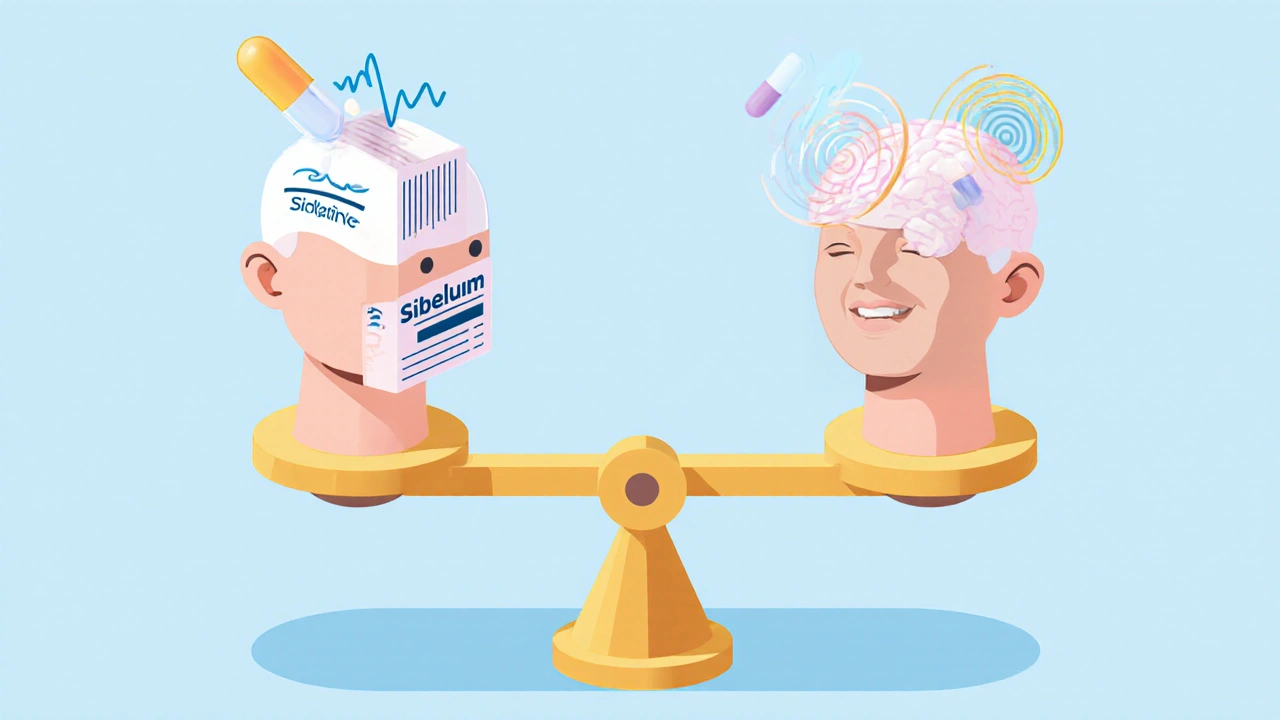If you’ve been prescribed Sibelium (Flunarizine) for migraines or vertigo, you’re not alone. But you might be wondering: is this the best option? Are there safer, cheaper, or more effective alternatives? Many people start on Flunarizine because their doctor recommends it - but few are told what else is out there. This isn’t about switching meds blindly. It’s about understanding your real choices.
What is Sibelium (Flunarizine) actually doing?
Sibelium is the brand name for flunarizine, a calcium channel blocker originally developed in the 1970s. It’s not a painkiller. It doesn’t stop a migraine once it starts. Instead, it works as a preventive - reducing how often attacks happen and how severe they are. It also helps with vertigo by calming overactive signals in the inner ear and brain.
Studies show flunarizine reduces migraine frequency by about 50% in around 60% of users after three months. That’s solid. But it’s not magic. And it comes with trade-offs.
Common side effects include drowsiness, weight gain, depression, and, in rare cases, Parkinson-like symptoms (tremors, stiffness). These aren’t rare enough to ignore. About 1 in 10 people stop taking it because of side effects. If you’re already feeling sluggish from chronic migraines, adding more fatigue isn’t helpful.
Alternative 1: Betahistine - The Vertigo Specialist
If your main issue is vertigo - that spinning, nauseous feeling - betahistine (sold as Serc or Betaserc) is often the first choice in the UK and Europe. Unlike flunarizine, betahistine works directly on the inner ear. It increases blood flow to the vestibular system and helps your brain adapt to balance signals.
A 2022 Cochrane review found betahistine significantly reduced vertigo episodes compared to placebo, with fewer side effects than flunarizine. Most people tolerate it well: mild stomach upset is the biggest issue. No weight gain. No drowsiness. No risk of movement disorders.
But here’s the catch: betahistine doesn’t work well for migraines. If you have both vertigo and migraines, flunarizine might still be your best bet. But if it’s mostly vertigo - especially Ménière’s disease - betahistine is often preferred. Many GPs in Bristol start patients here before moving to flunarizine.
Alternative 2: Propranolol - The Long-Standing Migraine Preventive
Propranolol, a beta-blocker, has been used for migraine prevention since the 1960s. It’s cheaper than flunarizine, widely available as a generic, and recommended by NICE (UK’s health guidelines) as a first-line option.
How it works: it reduces blood vessel constriction and dampens overactive nerve signals in the brain. Studies show it reduces migraine frequency by 40-60% - similar to flunarizine. But it doesn’t help with vertigo.
Side effects? Fatigue, cold hands, low blood pressure, and sometimes sleep problems. If you have asthma, heart block, or low blood sugar, it’s not safe. But for healthy adults, it’s often the go-to because it’s been around so long - and the data is solid.
Many patients switch from flunarizine to propranolol because they can’t tolerate the weight gain or brain fog. One patient I spoke to in Bristol said: “I lost 8kg in three months after switching. My energy came back. My migraines didn’t get worse.”
Alternative 3: Topiramate - For Tough Cases
If you’ve tried flunarizine and propranolol and still get migraines every week, topiramate (Topamax) is the next step. It’s an anticonvulsant repurposed for migraine prevention. It’s more powerful - but also more intense.
Topiramate reduces migraine days by 50% or more in about 70% of users. But side effects are real: brain fog, tingling in fingers, kidney stones, weight loss (which some want, others don’t), and a small risk of glaucoma.
It’s not used first-line. It’s reserved for people who haven’t responded to other options. If you’re a teacher, a driver, or someone who needs sharp focus, the mental fog can be a dealbreaker. But for someone with debilitating migraines who’s tried everything else, it’s a game-changer.
Unlike flunarizine, topiramate doesn’t touch vertigo. So if you have both, you might still need flunarizine - or a combination.

Alternative 4: Candesartan - The Blood Pressure Drug That Helps Migraines
Here’s one most people haven’t heard of: candesartan, an ARB (angiotensin receptor blocker) used for high blood pressure. But research shows it’s surprisingly effective for migraines.
A 2021 trial published in The Lancet Neurology found candesartan reduced migraine days by 45% - comparable to propranolol and flunarizine. And the side effect profile? Mostly mild: dizziness, fatigue, and occasionally elevated potassium levels.
Why isn’t it more popular? Because it’s not officially licensed for migraines in the UK. Doctors prescribe it “off-label,” meaning they’re using it for something outside its approved use. But it’s safe, and many neurologists use it when beta-blockers or calcium channel blockers fail.
If you’re already on blood pressure medication, your doctor might consider switching you to candesartan to kill two birds with one stone.
Alternative 5: Lifestyle + Supplements - The Non-Drug Approach
Medication isn’t the only path. For many, combining small lifestyle changes with supplements makes a big difference - and avoids drug side effects entirely.
Magnesium: Low magnesium is linked to migraines. Taking 400-500mg of magnesium citrate daily can reduce attack frequency by up to 40%, according to a 2020 meta-analysis. No side effects beyond loose stools.
Coenzyme Q10: A 2021 study in Neurology showed 300mg daily reduced migraine days by 50% in 61% of participants. Safe, well-tolerated.
Riboflavin (B2): 400mg daily. Works slowly - takes 3 months - but has strong evidence.
These aren’t quick fixes. But they’re low-risk. Many people use them alongside lower doses of medication - or as a way to eventually come off drugs.
Also, sleep hygiene, stress management, and avoiding triggers (like red wine, aged cheese, or bright screens) matter more than most people think. One patient in Bristol cut her migraines from 12 days a month to 3 just by fixing her sleep schedule and reducing caffeine.
How to Choose: A Simple Decision Guide
Let’s make this practical. Here’s how to think about it:
- Vertigo is your main problem? → Start with betahistine.
- Migraines only, no vertigo? → Try propranolol first. It’s cheaper and has more long-term safety data.
- Propranolol didn’t work or caused side effects? → Try flunarizine - but watch for weight gain and drowsiness.
- Still getting migraines after 3 months? → Talk to a neurologist about topiramate or candesartan.
- Want to avoid drugs? → Try magnesium, CoQ10, and riboflavin for 3 months. Track your headaches.
- Have both migraines and vertigo? → Flunarizine is still the only drug that helps both. But consider adding supplements to reduce the dose.
What About Newer Drugs Like CGRP Inhibitors?
You might have heard of drugs like erenumab (Aimovig) or fremanezumab (Ajovy). These are monthly injections that block a protein linked to migraines. They’re highly effective - up to 70% of users see a 50% reduction in migraine days.
But they’re expensive (£500+ per month in the UK). NHS funding is strict: you usually need to have tried at least three oral preventives (like flunarizine, propranolol, topiramate) first. They’re not a first option. But if you’ve tried everything else and still suffer, they’re worth discussing.
Final Thoughts: It’s Not One-Size-Fits-All
Flunarizine works. But it’s not the only tool in the box. The best treatment depends on your symptoms, your body’s response, your lifestyle, and your tolerance for side effects.
Don’t stay on a drug just because it was your first option. If you’re tired, gaining weight, or feeling down, talk to your doctor. There’s likely a better fit.
And if you’re scared of medication? Start small. Try magnesium. Fix your sleep. Track your triggers. Sometimes the simplest changes make the biggest difference.
Is flunarizine better than betahistine for vertigo?
Betahistine is usually preferred for vertigo alone because it targets the inner ear directly and has fewer side effects. Flunarizine works too, but it’s a broader brain stabilizer and carries more risk of drowsiness and weight gain. If you have both vertigo and migraines, flunarizine may be the better choice.
Can I take flunarizine and propranolol together?
Some neurologists prescribe them together for patients with severe, treatment-resistant migraines. But combining them increases the risk of low blood pressure, extreme fatigue, and dizziness. It’s only done under close supervision and usually after other options fail.
Does flunarizine cause depression?
Yes. Flunarizine can cause or worsen depression in some people, especially with long-term use. If you notice low mood, loss of interest, or hopelessness after starting it, tell your doctor immediately. It’s not common, but it’s serious enough to warrant stopping the drug.
How long does it take for flunarizine to work?
It usually takes 6 to 8 weeks to see the full preventive effect. Some people notice a reduction in frequency after 3-4 weeks, but don’t give up before 2 months. Migraine prevention is slow - it’s not like a painkiller.
Can I stop flunarizine suddenly?
No. Stopping suddenly can cause rebound headaches or worsen vertigo. Always taper off slowly under medical supervision. Your doctor will likely reduce your dose by 2.5mg every 1-2 weeks.
Next Steps: What to Do Now
Start by tracking your symptoms for two weeks. Note: how often you get headaches or dizziness, how long they last, what you ate, how much you slept, and if stress was high. Bring this to your doctor.
If you’re on flunarizine and feeling off - tired, heavy, low - ask: “Could there be a better option for me?” Don’t accept side effects as normal.
If you’re not on anything yet, ask about betahistine (for vertigo), propranolol (for migraines), or supplements like magnesium. There’s no rush. But there are better paths than just staying on the first drug you were given.
